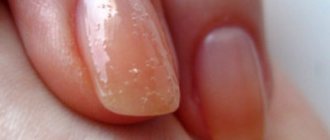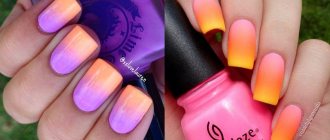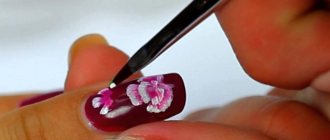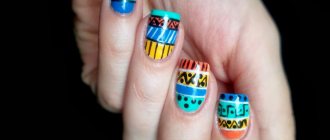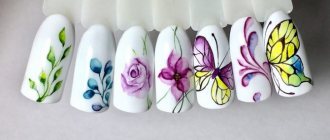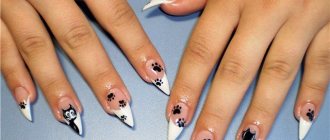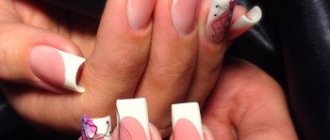General information
The pterygium of the nails is the lower, thin layer of the cuticle. It is able to grow over the entire surface and fit tightly to the nail plate, so to speak “sticking” during the growth of the nail and thereby covering its surface. Since the nail apparatus is a constantly renewing formation, capable of restoration (with the exception of the matrix), the growth of pterygium is a fairly common problem.
Formation, structure and functions of the nail
Normal growth of nails is observed from the moment of birth, their intrauterine development is extremely slow and begins with the gradual formation of dense structures in the places where future nails are localized, followed by the formation of growth buds and a matrix zone.
Nail structure
The normal structure of the nail plate in humans consists of a root - the main growth zone (a white hole protruding outwards), a body and an edge. They are surrounded and somewhat “hidden” under the posterior and two lateral ridges, which form the nail sinuses. The constantly growing cuticle with pterygium protects the nail root from pollution, aggressive environments, pathogenic bacteria and other types of infections. Under the roller there is a primary young nail - a matrix consisting of a layer of germ cells - onychoblasts, located in the subungual bed (hyponychium) and connected to the root. It determines the nail shape and thickness, growth rate, structure and color, as well as the chemical composition and, in general, the general condition. The processes of renewal and keratinization occur in it. The hyponychium, with its fibrous structure, determines the nail pattern and forms a fixing, fixed base woven into the bony phalanx - directly into its periosteum.
The main functions of the nail include protecting the fingertips from injury, fine movements, access to deep and small objects, assisting in grasping objects, and combating skin itching.
Nail plate.
The nail plate (nail), in turn, consists of many transparent keratinized plates, folded like tiles. Thanks to this structure, the nail plates have a porous structure. They actively absorb and release (sweat) moisture, 100 times more intense than human skin. Exudation through the nails accounts for 12-15% of the exudation of the entire surface of the body. The high permeability of the nail plates allows the effective use of medicinal varnishes and creams to affect the tissues under the nail. Due to this permeability, in people whose hands are often in contact with water, the nail plates become noticeably thicker over time.
Pathogenesis
The structure of the pterygium is connective tissue and keratinized epidermal, most often made of dead cells. The term comes from the ancient Greek pterуx, which means wings. Pterygium on nails usually grows in large quantities in the areas where the cuticle transitions from the lateral ridges, hence the name “wing-like.” By its origin, it is a hypertrophy of the eponychium - the living protective tissue around the nail plate.
The pathogenesis is usually based on a violation of blood circulation and blood supply to the nail apparatus. In this case, the cuticle begins to grow excessively forward and attach to the base of the nail.
What is the cuticle made of?
The structure of the nail cuticle is as follows:
- Eponychium. The top layer of the cuticle contains blood vessels and provides protection to the nail. It is careless use of manicure tools that leads to her cuts.
- Pterygium. The lower part of the cuticle represents the remains of the original layer, that is, a thin film that fuses with the plate. More often in males and children it occupies more than one third of the surface of the plate.
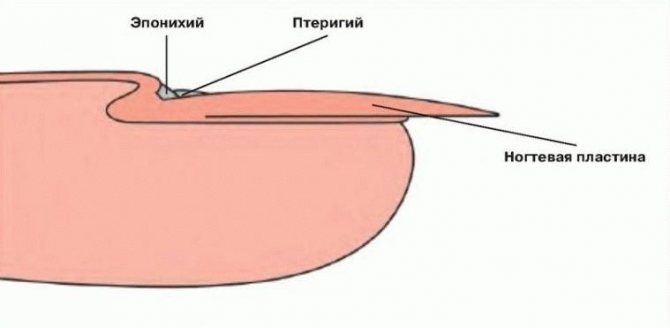
The edges of the cuticle are keratinized cells, which, when drying and peeling off, contribute to the formation of hangnails. They can occur due to insufficiently careful nail care, which manifests itself in the use of household chemicals based on acids and alkalis without gloves.
The cuticle is not an unnecessary element; it is “conceived by nature” to protect the delicate component of the nail - the matrix, which is the germinal area of the formation and development of new plate cells.
It is noted that frequent, systemic removal of this protective layer can lead to even more rapid and intense growth; this process is determined by the protective function of the human body. Therefore, there have been debates among manicurists for many years about removing or leaving the cuticle. It has been revealed that from frequent mechanical removal of it, the skin at the base of the nail turns red and swelling appears.
Supporters of “healthy” nails are of the opinion that this film should not be completely removed, but it is necessary to remove the pterygium with manicure tools, which creates the picture of unkempt and unsightly nails. The presence of eponychium is completely natural. Therefore, it is enough to polish it using hardware manicure. This can only be done by a specialist competent in this matter, since there is a high risk of injury to the cuticle and infection.

The pterygium must be removed due to the fact that excess skin in the periungual space clings to the plate and reduces its growth rate, which is reflected in the appearance of grooves and irregularities on the plate. The materials adhere extremely poorly to lumpy and rough nails. The excess cuticle that grows on the nail gradually loses moisture and cracks.
The following two parts of the cuticle are also distinguished: thick internal laminar and thin external.
The first consists of an internal endocuticle and an external exocuticle. These components consist of a glycoprotein, which is a chitin complex belonging to the category of high molecular weight polysaccharides, and protein.
The pore tubules in this film are unique pathways for the movement of secretions secreted by epithelial cells, these include wax, tannins and material for creating the cuticle.
Causes
The main cause of pterygia on the nails is circulatory disorders caused by injuries in particular - eponychium, internal or external physical and chemical influences, as well as inflammatory processes. Among the most common causes are vegetative-vascular diseases, lichen ruber and the habit of biting nails .
The severity differs significantly from person to person. At risk are men and children under 14 years of age who experience a powerful growth of pterygium against the background of delicate and thin skin of the nail folds and thin cuticle. They are more prone to frequent hand injuries, gnawing, irregular manicures and lack of nail care.
In what cases does pathological pterygium appear?
It is seen in this form when a person has a vegetative-vascular disease of the distal extremities, as well as if he is prone to the bad habit of biting his nails. In this case, the ground appears for the development of this pathology.
In rare cases, it may also appear due to a person having lichen planus.
It can be treated in the same way as described in the previous paragraph. It is advisable to use a remover, or steam your hands in a hot bath using essential oils.
Attention! In this case, it is not recommended to use edged manicure.
Tests and diagnostics
Nail growths are a cosmetic problem. Pterygium can be very inconspicuous and not cause any inconvenience, but when applying a decorative coating, aesthetic quality, neatness and durability are significantly reduced. Normally, the coating should last for at least 2 weeks; if the period is much shorter, this may be a sign of poor-quality removal of the pterygium and cuticle.
To study the size and extent of distribution of pterygium in laboratory conditions, biomicroscopy and keratotopography can be used. Vascular disorders are attempted to be detected using fluorescein angiography.
Detachments - the master’s mistake
One of the root causes is a poorly executed manicure; it definitely contributes to the detachment of gel polish from the cuticle.
The most popular manicure option among masters is a hardware manicure, so we will tell you what rules and steps should be followed so that the gel polish does not peel off and your clients do not have detachments from the cuticle:
- We treat the skin of our hands with an antiseptic;
- We give shape with a file;
- We buff the nail plate and remove the natural shine from it;
- We push back the cuticle using a pusher or an orange stick;
- Using a cutter (most often a flame is used), we carefully clean the pterygium. The cutter should be parallel to the cuticle so as not to cut through the nail. During processing we also grind the side rollers. This stage is performed at 15,000-17,000 rpm;
- Next, we remove the cuticle using one of two options: a cutting tool (scissors, nippers, tweezers) or a bur ball. In the second case, movements are carried out perpendicular to the nail plate. The cut is made with a 3-3.5 mm ball with minimal abrasiveness;
- Next, you can smooth the skin and cuticles with a polisher;
- One of the most important steps is to remove any remaining dust and degrease the plate using a lint-free cloth.
After completing all the steps, you need to apply a primer to dry the nail plate and raise the scales for better adhesion.
It is very important to make the base with a thin layer of base that suits the type of nail plate (how to choose the right base - see here). Next we proceed to leveling, covering with color and topcoat.
Treatment with folk remedies
There are a lot of folk remedies for caring for hands and nails. To prevent the formation of growths on the nail plates, it is recommended to: several times a month:
- treat nails with a soft brush dipped in olive oil and citric acid;
- make nourishing masks with kaolin, allantoin, mallow and cosmetic paraffin;
- treat the cuticle with essential oils, such as almond, lavender, tea tree or another plant that helps soften and soothe the skin;
- rub the nail growth areas and ridges with citrus fruits such as lemon, orange or grapefruit.
Useful video
Now you know absolutely everything about this element of the structure of the nail and cuticle. What causes it, how to treat it, how to slow down growth.
If you get rid of this, then do not forget to carefully monitor hygiene, perform circumcisions, and at least sometimes visit manicure centers. In this case, your nails will always be healthy.
If you find an error or traces of code (for example, individual characters >, ],=...), please select a piece of text and press Ctrl+Enter.
Prevention
Removal of cuticle and eponychium during hygienic manicure, without unnecessary trauma. Cuticle removers or cuticle removers can also be used for this. To soften the skin, it is recommended to soak your hands in a bath. Then, with light movements, the pterygia with the cuticle can be moved away using a manicure spatula and then trimmed with scissors. If traces of the pterygium remain, they can be carefully cleaned off using an orange wood stick.
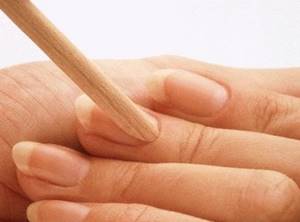
Removing remnants of pterygium using an orangewood stick
To slow down the growth of loss, you should regularly care for your nails, use creams and make softening hand baths at home weekly, which include soda, natural oils and sea salt.
How to slow down growth?
It is necessary to carry out manual circumcision at least once every three weeks, or use a “remover”. Try filing the cuticle with a nail file, moisturizing it, taking weekly finger baths, lubricating it with oils, creams or varnishes, washing your hands more often, or even buying a metal “pusher” for convenience.
“Pusher” is a manicure tool that allows you to push back the cuticle and model the nail hole with the highest precision.
If the skin itself is dry, it is advisable to apply creams to moisturize and make it softer. There is also the option of using wax, as it saturates the skin with vitamins and protects it.
Peculiarity! It is not recommended to use varnishes that contain acetone, as this will affect the formation of burrs.
Diet for pterygia on the nails
Fish diet
- Efficiency: from 3 to 5 kg per week
- Terms: from 3 to 14 days
- Cost of products: from 400 to 1000 rubles. in a day
Problems with nails may be evidence of a deficiency of vitamins (particularly E), minerals, or the result of systemic diseases. Therefore, at the first symptoms, you should consult a doctor and undergo a health examination, as well as adjust your diet by adding to your diet:
- seafood, in particular grilled, steamed, boiled or simply lightly salted fish;
- eggs and dietary meat;
- cheese and low-fat fermented milk products;
- vegetable oils, seeds and nuts;
- greens and vegetables;
- fruits and berries.



